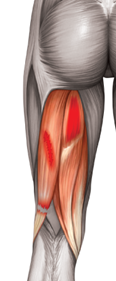
Hamstrings – only a runners’ problem?
 What are hamstrings?
What are hamstrings?
Hamstrings are the tendons connecting the group of large muscles at the back of the thigh to the bone. But the word is often used to refer to the entire group of muscles connecting the knee to the hip at the back of the thigh.
The Hamstring muscles bend the knee and straighten the hip and while not very important for walking and standing they are very important for running, jumping and climbing. So they get out of condition very quickly without regular exercise.
Legend has it that cruel masters would sever the hamstring tendons in slaves and prisoners to literally prevent them running away.
Common injuries / symptoms
Hamstring injuries are usually referred to as “muscle strains”. Which sounds like they barely matter at all right?
But a strain is an injury that stretches a muscle up to breaking point!
Hamstring injuries are graded from
- I – which is fairly minor
- II – a partial rupture
- III – a complete rupture.
Because the hamstrings are really only used during athletic activities, it is most often athletes that get hurt. Sudden acceleration during running, lunging and jumping are often the cause.
Treatment and management
Surgery is rarely used to treat hamstring injuries. Sometimes a Grade III complete tear will need to be stitched together, but up until this point good physiotherapy with a strong exercise programme is the best option.
For athletes, or those with a deadline, Magnetic Resonance Therapy (MRT) can dramatically speed up the healing and movement.
Prevention and recurrence
Recurrent hamstring injuries are common – it is vital to increase the strength in the injured leg to match the “good” leg. So without proper rehab you’re going to be back.
Stretching and a proper warm up is very important before every work out. And it is key to include calf stretches and core work to support the hamstrings. Quad work must always be balanced with hamstring work. Although this very interesting article talks about what else is going on when you stretch your hamstrings.
Athletes with a high arch foot are also more susceptible to hamstring injury – a proper gait analysis and foot support can prevent injuries and problems.

Leave a Reply